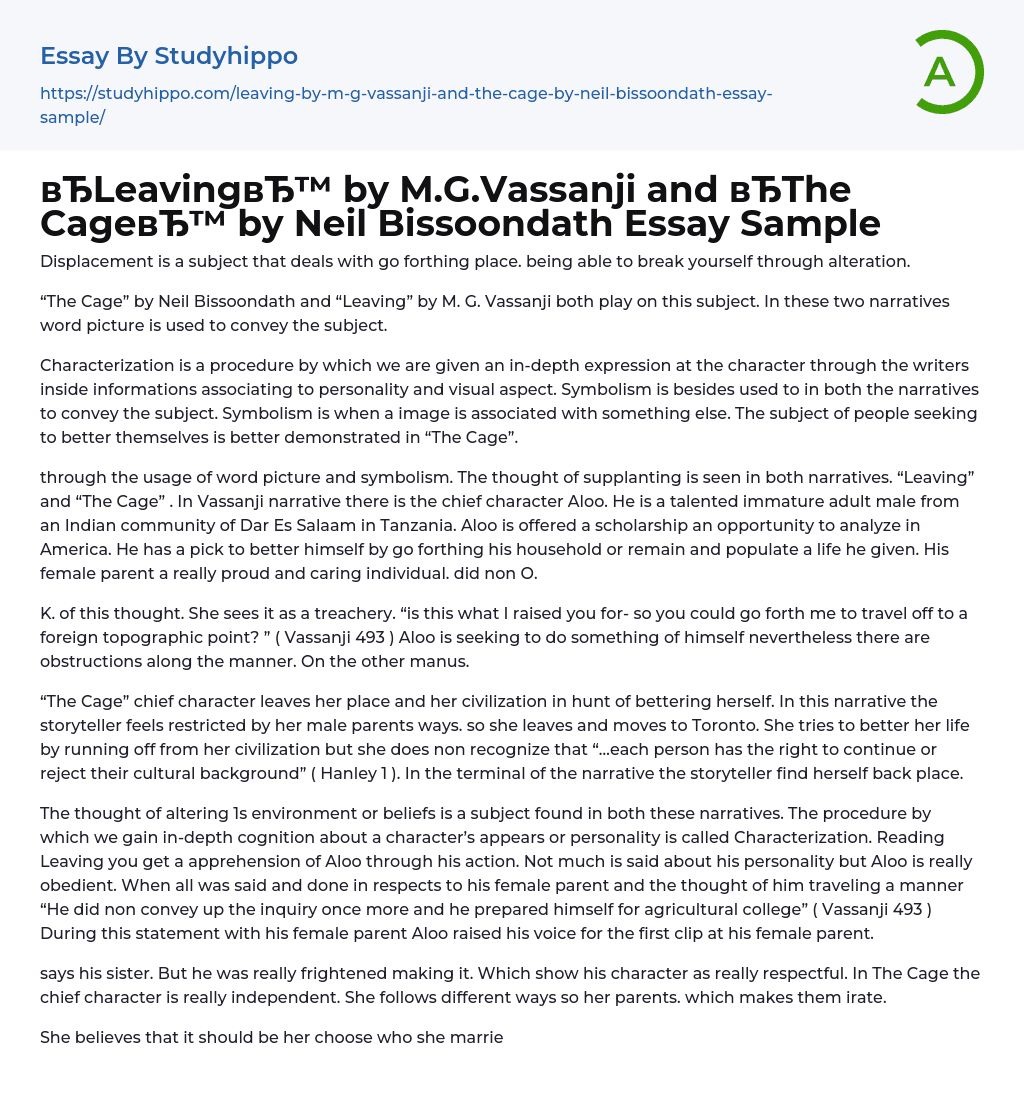

“Leaving by M.G.Vassanji and “The Cage by Neil Bissoondath Essay Sample
Displacement is the topic that encompasses leaving one's home and finding personal growth through change. Both "The Cage" by Neil Bissoondath and "Leaving" by M. G. Vassanji explore this theme.
Both narratives utilize word picture to depict the subject and offer insight into the characters. Characterization involves revealing details about a character's personality and appearance. Symbolism is also employed in both narratives to convey meaning by associating a image with something else. "The Cage" particularly showcases the theme of individuals striving for self-improvement through the powerful combination of word picture and symbolism.
The narratives "Leaving" and "The Cage" both delve into the concept of displacement. In "Leaving," Vassanji introduces Aloo, a gifted individual from an Indian community in Dar Es Salaam, Tanzania who is presented with an opportunity to pursue his stud
...ies in America.
He has the option to enhance his life by either departing from his family or remaining and continuing with the life he has been given. However, it is worth noting that his mother, who is both proud and caring, disapproves of this decision.
Both Aloo and the main character in "The Cage" encounter challenges while trying to enhance their lives and break free from their own cultures and surroundings. Aloo's mother perceives his aspiration to explore a foreign land as an act of disloyalty, wondering if that is what she brought him up for. Similarly, in "The Cage," the narrator feels confined by her father's traditions and departs from home in pursuit of personal growth. Despite the presence of , both narratives revolve around characters grappling with societal expectations and familial limitations.
In an effort to improve her life and distance herself from her own society
she moves to Toronto. However, she overlooks the fact that individuals have the option to embrace or reject their cultural heritage (Hanley 1). Ultimately, she comes back home by the end of the story. The idea of altering one's environment or convictions is a recurring motif in both narratives.
The process of gaining a deep understanding of a character's appearance or personality is known as Characterization. In the story Leaving, Aloo's actions provide insight into his character. Though not much is stated about his personality, it is clear that Aloo is very obedient. When it came to his mother's wishes and the idea of him leaving, he never brought up the question again and instead prepared himself for agricultural college (Vassanji 493). This was the first time Aloo raised his voice at his mother.
His sister says that he was truly scared while making it, which demonstrates his respectful character. In The Cage, the main character is highly independent and chooses different paths from her parents.
She becomes enraged because she desires the autonomy to select her own spouse, companions, and way of life. Nevertheless, her parents hold a contrary opinion which leads to frequent disagreements. In the midst of a heated debate regarding the direction she desires for her life, she boldly states, "I refuse to become somebody's wife."
According to Bissoondath (83), this provides us with a brief glimpse into her emerging independence. Both narratives utilize description to reveal the personality of the characters. In The Cage, the portrayal of the narrator aligns more harmoniously with the theme of the story. Symbols are employed in both narratives to represent the unseen.
In the narrative, Leaving, Aloo is depicted
as a bird in the final sentence. His departure is compared to a bird stretching its wings. According to Vassanji, Aloo, like a bird, has the ability to move freely.
In The Cage, the main character represents a bird trapped in a coop. Her brother had recently brought home a new small bird. However, there was something wrong with this particular bird.
The bird's singing was only a single, pure, and shrill whistle that summoned my brother.
Bissoondath (89) claims that both my mother and I were involuntarily taken to a location where we felt confined, just like the lifeless bird found in a cage on the ground. Neither of us wished to be in this situation.
By utilizing imagery and symbolism, The Cage effectively depicts the theme of substitution. The protagonist strongly believed that remaining confined would result in her demise, envisioning herself motionless on the enclosure's floor. Both narratives employ symbolism to convey the characters' emotions.
The use of word pictures in The Cage is emphasized to help readers comprehend the characters and their actions. Moreover, symbolism has a significant role in this work.
So, Leaving. The Cage is the better narrative in terms of the subject of supplanting.
Plants Cited
- Bruce Meyer. erectile dysfunction. The Stories: Contemporary Short Fiction Written in English. Prentice Hall Canada inc. 1997
- Hanley. “Social work Proceeding” hypertext transfer protocol: //www. arcaf. net/social_work_proceeding/ftp_files5/Hanley.
pdf (15 July.2002)
Paul "Themes" hypertext transfer protocol: //www.emory.edu/ENGLISH/Bahri?Vassanji (15 July, 2002)
The website uweb.ucsb.edu/~rbb0/academic/projects/okri/richards.html was last updated on July 15, 2002.
- Child essays
- Childcare essays
- Child labor essays
- Doll essays
- Adoption essays
- Aunt essays
- Babies essays
- Bedroom essays
- Caring essays
- Children essays
- Daughter essays
- Divorce essays
- Dog essays
- Dysfunctional Family essays
- Family Tradition essays
- Family Values essays
- Father essays
- Foster Care essays
- Friends essays
- Grandparent essays
- Home essays
- Hometown essays
- Husband essays
- Jealousy essays
- Love essays
- Marriage essays
- Mother essays
- Online Dating essays
- Parenting essays
- Parenting Teens essays
- Parents essays
- Relationship essays
- Room essays
- Sibling essays
- Sister essays
- Wedding essays
- Wife essays
- John Locke essays
- 9/11 essays
- A Good Teacher essays
- A Healthy Diet essays
- A Modest Proposal essays
- A&P essays
- Academic Achievement essays
- Achievement essays
- Achieving goals essays
- Admission essays
- Advantages And Disadvantages Of Internet essays
- Alcoholic drinks essays
- Ammonia essays



